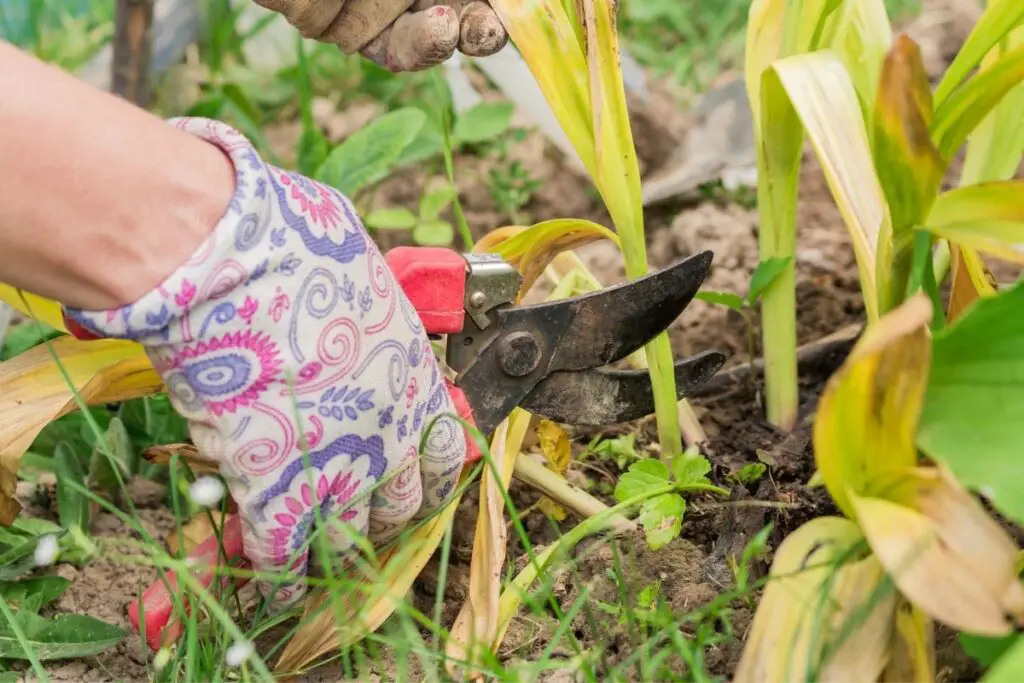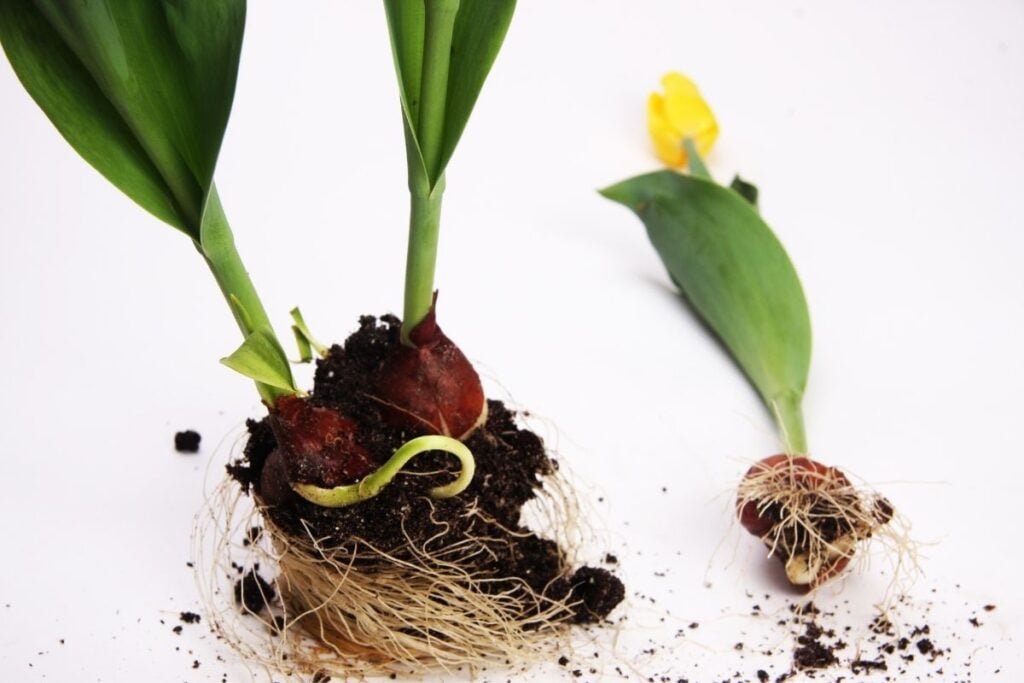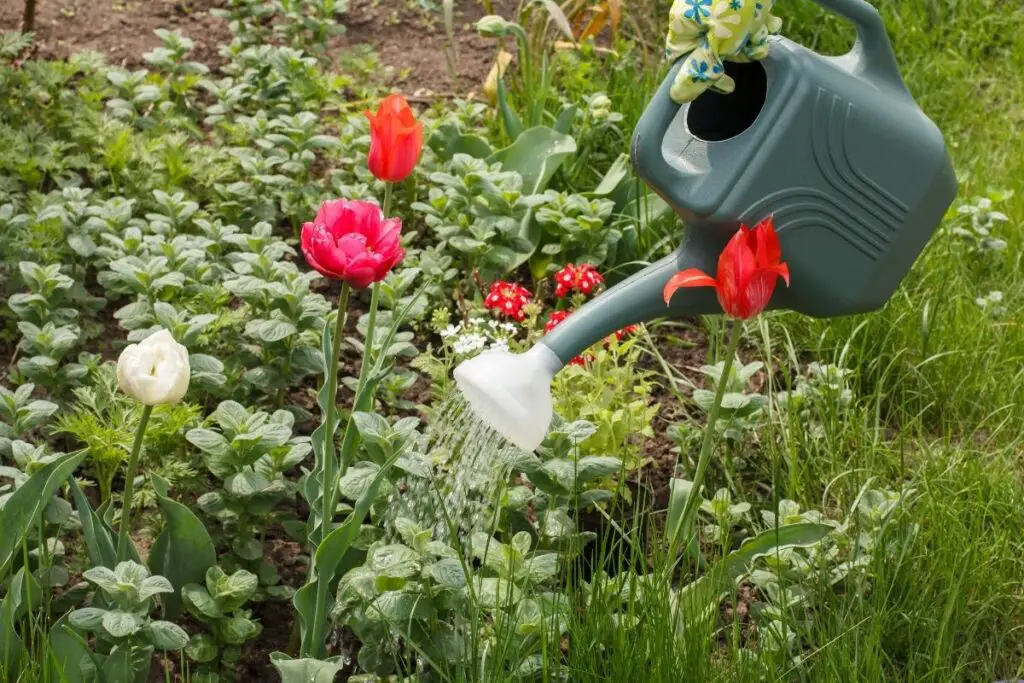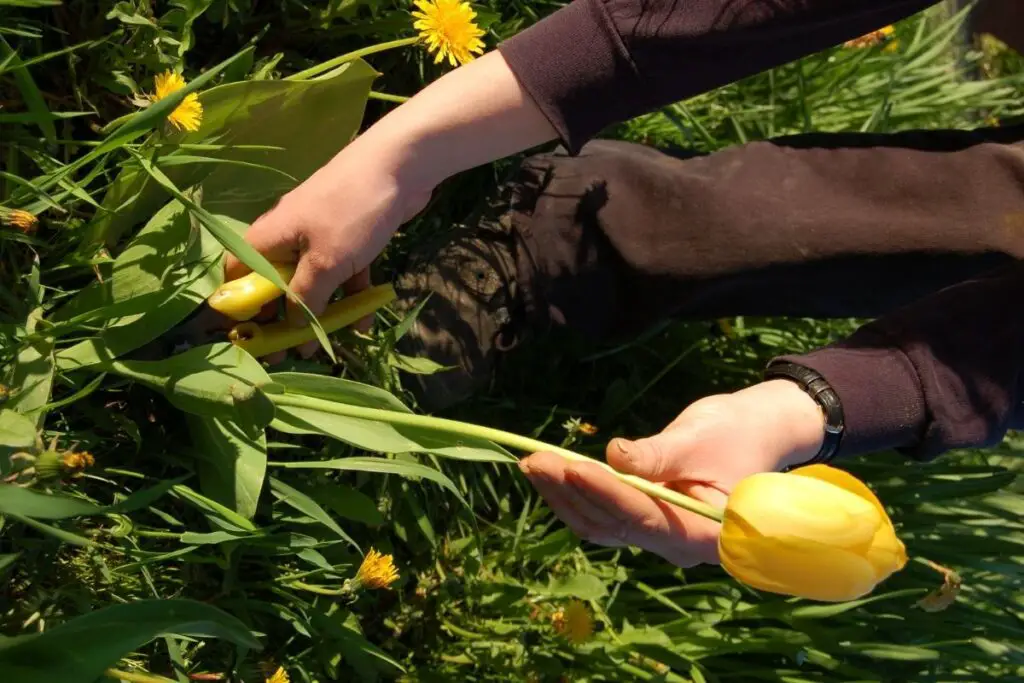Tulips are low-maintenance plants, but they need proper care at the end of the season so that the bulbs remain healthy for next year’s flowering.
So, in this article, we shall learn what to do with tulips at the end of the season. What are the steps you need to take to keep your tulips healthy?
As a general rule, you need to deadhead the spent flowers of tulips as the season ends. Also, when the foliage starts turning yellow, you have to remove them too. Then after six weeks, depending on the variety, you can either dig up the bulb or leave them there to rebloom next year.
Taking care of the tulips at the end of the season is necessary to keep the bulbs healthy and encourage them to rebloom the following year.
In this article, we will discuss the actions to be taken with tulips at the season end and aftercare for blooming tulips. We will also cover information about encouraging them to bloom every year.

What to do with tulips at the end of the season?
At the end of the season, tulips finish blooming. It is the aftercare they require at the season end.
When the tulip flowers fade, the plant needs deadheading to stop producing seeds. After that, the leaves should be left alone.
The leaves are still healthy and capable of photosynthesis. The bulbs gather energy from the foliage. Remove the foliage after they turn completely yellow.
Speaking of bulbs, they can either be dug up or left in the ground, depending upon the climate. Let’s learn a bit more in detail.
Also read: Do Tulips Grow Back Every Year? (+How To Encourage To Grow Back)
Don’t harvest the tulips. Only remove the faded flowers.
The tulips will fade off and die at the end of the season. This scene in the plant may alarm you to cut off the whole tulips. Don’t do this.
When the blooms fade, you only need to remove the dead flower and deadhead them. Leave the stems and foliage alone. They are green and still capable of performing good photosynthesis.
The leaves will gather energy from the sunlight through photosynthesis. The bulbs will further consume this energy to flower in the next year.
Cutting off the tulip stems and foliage will only stop the bulbs from gathering any energy, and they won’t support good flowering in the next year.
Avoid letting them go for seed.
As I said earlier, when the flowers fade, deadheading is needed. If the flower is not removed, they will start focussing on producing seeds.
If you let the plant go to seeds, the bulbs will not consume enough energy and nutrients for the next year blooming.
Letting the spent flowers remain in the plant will force the plant to form seeds in them. This can hurt the plant’s flowering in the next year. Thus, deadheading is needed.
Remove foliage
You should remove the foliage when the leaves turn yellow 6 weeks after the blooms have faded off.
Within 6 weeks, the bulbs will absorb all the energy and nutrients from the foliage. This assists the bulbs to flower profoundly in the next year.
When the foliage decays and turns yellow, it is time to prune them off.
The dead leaves will become so weak that pruning might not be necessary in some cases. Only slight snipping off will remove the foliage from the plant.
Looking for gardening supplies? We have tested 100's of products before recommending them to you guys. Check out our best pick below:
| Image | Gardening Supplies | Best Price? |
|---|---|---|
 Top
Top Top
Top | Raised Garden Bed Kit | Check On Amazon |
 | XLUX Soil Moisture Meter, Plant Water Monitor, Soil Hygrometer Sensor for Gardening, Farming, Indoor and Outdoor Plants, No Batteries Required | No Results |
 Top
Top Top
Top | 82 Pcs Garden Tools Set and Extra Succulent Tools Set | Check On Amazon |
 | Joeys Garden Expandable Garden Hose with 8 Function Hose Nozzle, Lightweight Anti-Kink Flexible Garden Hoses, Extra Strength Fabric with Double Latex Core, (50 FT, Black) | No Results |
 Top
Top Top
Top | Dual Chamber Compost Tumbler | Check On Amazon |
 Top
Top Top
Top | Sunnyglade Plant Stakes | Check On Amazon |
 Top
Top Top
Top | Organic Cold Pressed Neem Seed Oil | Check On Amazon |
 Top
Top Top
Top | Mighty Mint Gallon :-Insect and Pest Control Peppermint Oil | Check On Amazon |
 Top
Top Top
Top | Scotts DiseaseEx Lawn Fungicide | Check On Amazon |
 Top
Top Top
Top | Jacks Classic 20-20-20 All Purpose Fertilizer | Check On Amazon |
 Top
Top Top
Top | 30,000 Seeds Pollinator Attracting Wildflower Mixture | Check On Amazon |
 Top
Top Top
Top | Survival Vegetable Seeds Garden Kit-Over 16,000 Seeds | Check On Amazon |
Fertilize the plant
Fertilizing the plant after removing flowers will benefit the plant with a good amount of nutrients. The bulbs are still full of nutrients, and the green leaves are still capable of photosynthesis.
Fertilizing the tulips will give the bulbs an extra booster. Though the bulbs are full of nutrients, some fertilizer can give extra fuel to the bulbs and save them from any further nutrient deficiency.
You can either use organic fertilizer or an all-purpose fertilizer.
You can add a few-inch layer of compost in the soil bed. This will encourage solid and healthy bulbs.
Add the compost during the early fall months. This will help the bulbs to flower profusely in the spring.
A balanced all-purpose fertilizer will also help the bulbs to remain healthy. Apply fertilizer very carefully. Read the instructions before usage.
Apply the fertilizer on the top surface of the soil and not directly on the bulbs. Do it during the fall and spring.
Dig up the bulbs or not?

Generally, the tulips don’t need to be dug up each year. Digging them up every 3-4 years will be ideal for them. Within these years, the bulbs will multiply to produce more baby bulbs. This will help in getting more bulbs, but the plant will receive a lot of nutrients because of so many bulbs.
Dig up the bulbs if you want. But you will have tulips only when you replant them in the fall. So, if you are okay with replanting them every year, then you can dig them up.
Moreover, your region will also depend on digging up the bulbs. If you live in a hot climatic region, you will need to dig them up, store them in the cold, and replant them in the fall.
If your bulb is doing very well in its current location and your region doesn’t have very hot weather, you can let the bulbs stay in the ground.
You just need to ensure that the bulbs are planted deep enough, 8-12 inches deep. This will protect them from harsh weather.
Also read: Do Tulips Need To Be Dug Up Every Year? (When+How)
Store the bulbs
If you want to dig up the plants and store them, wait until the foliage dies. Then dig them up from the ground. Let the bulbs dry for a week. Keep them in the dark and cool location.
Once they are dry, store them in a paper bag or a tray. Fill the bag or tray with perlite or dry peat moss.
After packing them well:
- Keep them stored in a dry and cold place.
- Ensure the temperature they require for storage is within 35°F and 50°F.
- Replant them again in the fall.
How to encourage tulip flowers to re-bloom?

If the bulbs are healthy and ideal for re-blooming, they are bound to come back and bloom every year.
With proper care, they will flower the following year. Either you dig up bulbs to store them or leave them in the ground.
Let’s see how the tulips can be encouraged for coming back each year.
Choosing the correct type of tulips
Selecting the right kind of tulips is essential when you want them to come back every time. While buying tulips, you should check the labels, whether they will naturalize or will come back or not.
Species or botanical tulips are good choices. Hybrids won’t work because they quickly lose their ability to come back, except for some varieties.
The hybrids that can perennialize are the Darwin hybrids, especially red, orange, rose, yellow, and combination colors. Emperor tulips and Triumph tulips will also re-bloom.
You can try the Species variety that will re-bloom each year. You can try the old-fashioned tulips, i.e., the heirlooms, which are forgiving and promises to re-bloom every year.
Location
Generally, we know that you should plant the tulips in a site where they can get sufficient sun rays throughout the day.
You should also consider another thing while planting tulips. If you live in a hot region, you need to plant them away from house foundations, driveways, or concrete areas.
These concrete structures will warm up the tulips during winter, affecting the next year blooming. The tulips will need cold winter to re-bloom for strengthening the bulbs and roots and encourage next year.
Also read: Where Is The Best Place To Plant Tulips? (+Factors To Consider)
Well-drained soil
You should plant the tulip bulbs in well-drained soil. This will encourage them to naturalize and come back every year.
Tulips will not need a lot of water, only 1 inch per week. Add a layer of compost or mulch to keep the soil healthy, fertile, and well-drained.
You can plant tulips in mounds. This will ensure that the tulip soil bed is well-drained than the other surrounding soil. Well-drained soil will keep the bulbs healthy and promote re-blooming.
Also read: What Kind Of Soil Is Good For Tulips? (Best Soil Mix)
Planting depth
You must plant the tulip bulbs at an appropriate depth, about 8 to 10 inches deep. If you add a layer of mulch at the tulip soil bed, consider both the soil and mulch while measuring the depth.
If you add 2 layers of mulch, you should plant your tulip bulb 6 inches deep in the soil. So, 6-inch soil and 2-inch mulch will equal 8-inch depth.
If you want the tulip bulbs to remain in the ground at the end of the season, you should plant them 10 to 12 inches deep.
Don’t go too deep, as that can create short stems. This depth will protect the tulips from harsh environmental conditions.
Water the tulip bulbs after planting. Don’t overwater. Just keep the soil evenly moist. Proper watering will promote strong root growth before winter dormancy. This will further keep the bulbs healthy for further blooming.
Allow the tulip leaves to die naturally
When the flower fades at the end of the season, you might feel tempted to cut the leaves too. But you shouldn’t do that. You must allow the leaves to die naturally.
The green leaves will still be capable of photosynthesis after the flower dies. The bulbs gather all the energy from the leaves for re-blooming next year.
Wait until the leaves naturally turn yellow and die.
Fertilize the tulips
After you remove the fade tulips, you can still fertilize the tulips. Though the tulip bulbs are already carrying a lot of nutrients, fertilizing them can give them fuel to prevent nutrient deficiency.
Try using a phosphorous-rich fertilizer. This will promote abundant blooms in the plant.
Fertilize during the fall and spring. You can use a bulb fertilizer too to boost the bulbs.
You can add a layer of compost to condition the soil bed for organic fertilizer.
Also read: What Is The Best Fertilizer For Tulips? (Organic+Inorganic)
Where should you trim the tulip stems?

The tulip flowers should be removed when they start shriveling at the end of the season. You need to cut them before they start focussing on seeds.
When you remove the flowers, the leaves save energy from making seeds. This energy further gets used by bulbs for the next year blooming.
For trimming the dead tulips, make the cut where the stem joins the foliage. You can either wait until the tulip petals start falling or just prune them when the flower starts shriveling.
But remember not to do anything with the leaves until they turn yellow.
While cutting the yellow leaves, cut the leaves at their ground level. Sometimes, you won’t even need cutting. Slight pulling or snapping would work.
Final thoughts
Tulips are loved because of their stunning colors and distinctive shapes. If you want these colors every year, you need to care for them properly.
Remove the spent flowers to stop them from having seeds. Let the leaves die naturally. Wait until they become yellow. The bulbs will absorb energy from the green foliage. Bulbs will utilize the saved energy from creating seeds for next year’s blooms.
Digging up the bulbs depends on you and the region you live. If the bulbs are doing well in their place and the climate is ideal, you can let the bulbs remain underground.
Fertilize them with a bulb fertilizer to boost the bulbs and prevent nutrient deficiency. That’s all you need to do to allow the tulips to come back each year.
Source: Wikipedia, North Dakota Stae University, The Royal Horticultural Society.
